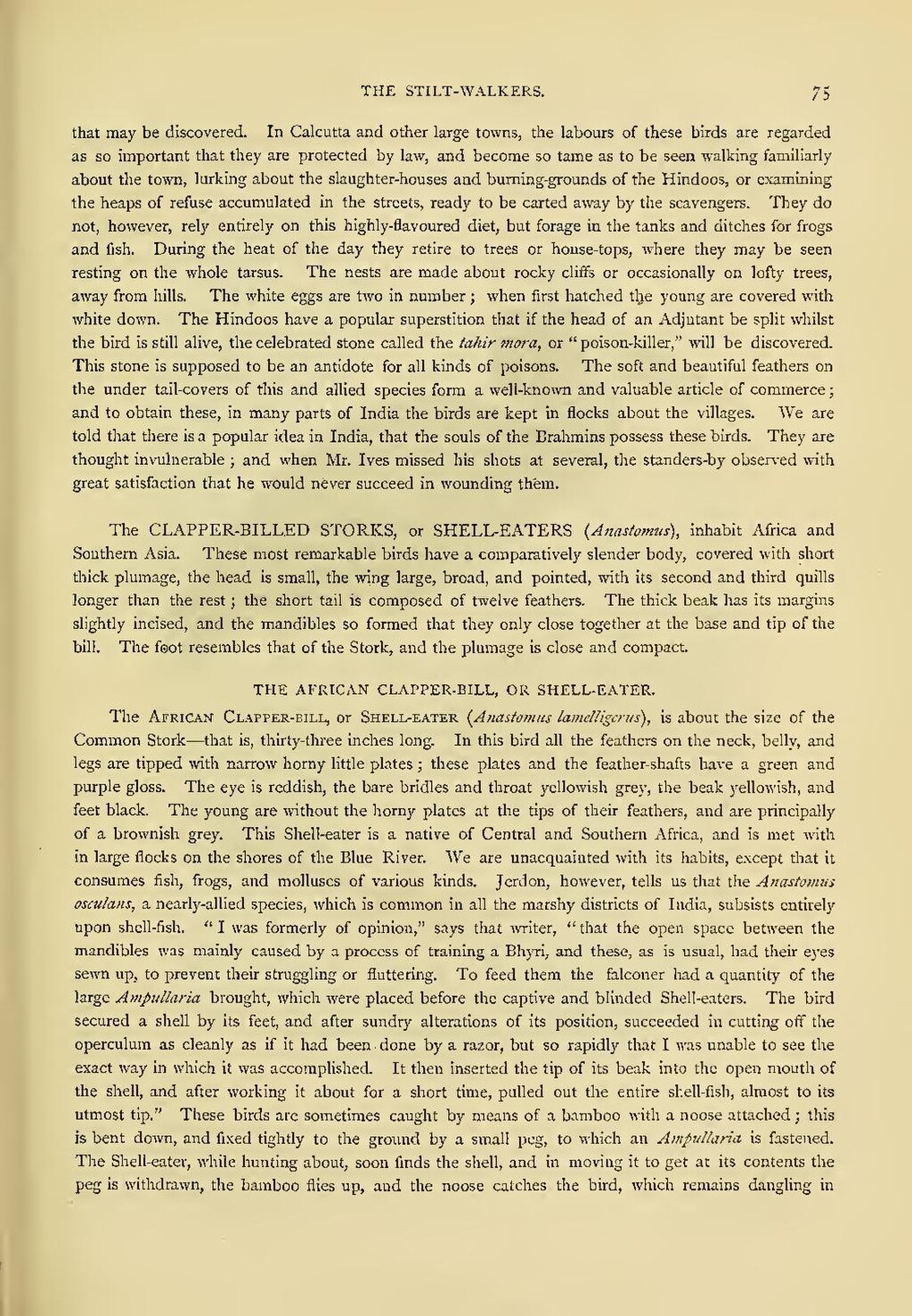that may be discovered. In Calcutta and other large towns, the labours of these birds are regarded as so important that they are protected by law, and become so tame as to be seen walking familiarly about the town, lurking about the slaughter-houses and burning-grounds of the Hindoos, or examining the heaps of refuse accumulated in the streets, ready to be carted away by the scavengers. They do not, however, rely entirely on this highly-flavoured diet, but forage in the tanks and ditches for frogs and fish. During the heat of the day they retire to trees or house-tops, where they may be seen resting on the whole tarsus. The nests are made about rocky cliffs or occasionally on lofty trees, away from hills. The white eggs are two in number; when first hatched the young are covered with white down. The Hindoos have a popular superstition that if the head of an Adjutant be split whilst the bird is still alive, the celebrated stone called the tahir mora, or "poison-killer," will be discovered. This stone is supposed to be an antidote for all kinds of poisons. The soft and beautiful feathers on the under tail-covers of this and allied species form a well-known and valuable article of commerce; and to obtain these, in many parts of India the birds are kept in flocks about the villages. We are told that there is a popular idea in India, that the souls of the Brahmins possess these birds. They are thought invulnerable; and when Mr. Ives missed his shots at several, the standers-by observed with great satisfaction that he would never succeed in wounding them.
The CLAPPER-BILLED STORKS, or SHELL-EATERS (Anastomus), inhabit Africa and Southern Asia. These most remarkable birds have a comparatively slender body, covered with short thick plumage, the head is small, the wing large, broad, and pointed, with its second and third quills longer than the rest; the short tail is composed of twelve feathers. The thick beak has its margins slightly incised, and the mandibles so formed that they only close together at the base and tip of the bill. The foot resembles that of the Stork, and the plumage is close and compact.
THE AFRICAN CLAPPER-BILL, OR SHELL-EATER.
The African Clapper-bill, or Shell-eater (Anastomus lamelligerus), is about the size of the Common Stork—that is, thirty-three inches long. In this bird all the feathers on the neck, belly, and legs are tipped with narrow horny little plates; these plates and the feather-shafts have a green and purple gloss. The eye is reddish, the bare bridles and throat yellowish grey, the beak yellowish, and feet black. The young are without the horny plates at the tips of their feathers, and are principally of a brownish grey. This Shell-eater is a native of Central and Southern Africa, and is met with in large flocks on the shores of the Blue River. We are unacquainted with its habits, except that it consumes fish, frogs, and molluscs of various kinds. Jerdon, however, tells us that the Anastomus osculans, a nearly-allied species, which is common in all the marshy districts of India, subsists entirely upon shell-fish. "I was formerly of opinion," says that writer, "that the open space between the mandibles was mainly caused by a process of training a Bhyri, and these, as is usual, had their eyes sewn up, to prevent their struggling or fluttering. To feed them the falconer had a quantity of the large Ampullaria brought, which were placed before the captive and blinded Shell-eaters. The bird secured a shell by its feet, and after sundry alterations of its position, succeeded in cutting off the operculum as cleanly as if it had been done by a razor, but so rapidly that I was unable to see the exact way in which it was accomplished. It then inserted the tip of its beak into the open mouth of the shell, and after working it about for a short time, pulled out the entire shell-fish, almost to its utmost tip." These birds are sometimes caught by means of a bamboo with a noose attached; this is bent down, and fixed tightly to the ground by a small peg, to which an Ampullaria is fastened. The Shell-eater, while hunting about, soon finds the shell, and in moving it to get at its contents the peg is withdrawn, the bamboo flies up, and the noose catches the bird, which remains dangling in
